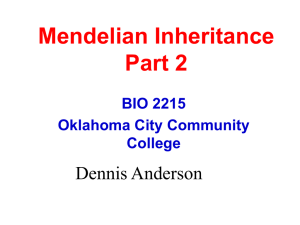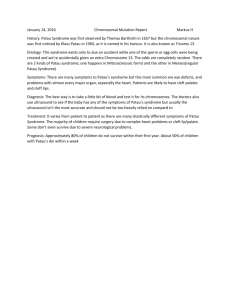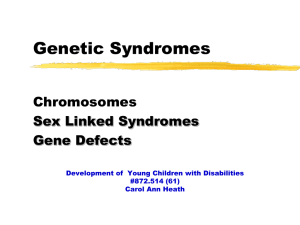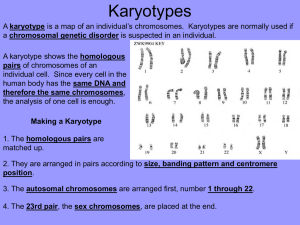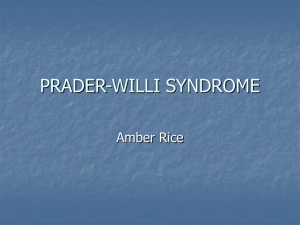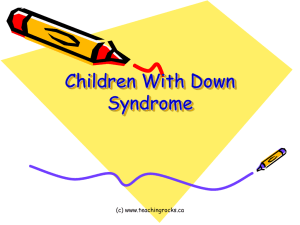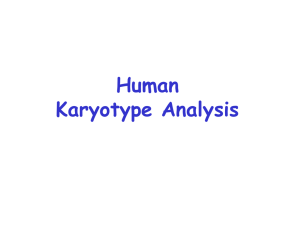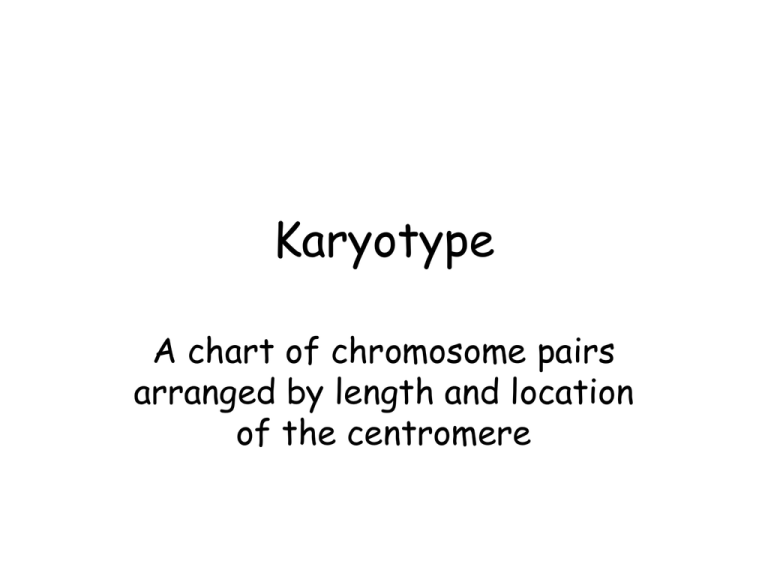
Karyotype
A chart of chromosome pairs
arranged by length and location
of the centromere
How are karyotypes made?
• Somatic cells (remember
these are body cells) in
metaphase are grown and
then dropped onto a slide
bursting the nucleus.
• The chromosomes are
photographed, paired up
and arranged by size.
Karyotype
Normal Human Karyotype
Sex Chromosomes
• The sex of the individual can be
determined by examining the sex
chromosomes.
• XX is a female
• XY is a male
Karyotype Notation
• 1. List the total number of chromosomes
(46 is normal for humans)
• 2. List the sex chromosomes.
• 3. List any extra or missing chromosomes
What is the sex of this individual?
XY = male
Notation:
46XY
And this one?
Klinefelter syndrome
Notation:
47 XXY
Klinefelter syndrome
• Klinefelter's syndrome is a condition that
occurs in men who have an extra X
chromosome in most of their cells. The
most common symptom is infertility.
• Scientists believe the XXY condition is one
of the most common chromosome
abnormalities in humans. About one of
every 500 males has an extra X
chromosome, but many don't have any
symptoms.
47XXY (Klinefelter’s)
Karyotypes
• Karyotypes are used to identify
defects in the chromosomes like:
• Missing chromosomes
• Multiple chromosomes
Do you see a problem?
Trisomy 21
Notation:
47 XY +21
Trisomy
• Trisomy: 3 copies of one chromosome
instead of the normal 2.
• Nondisjunction: (junction means
joined) a chromosome pair fails to
separate during meiosis
• One cell ends up with 3 copies of a
chromosome
Trisomy 21 or Down Syndrome
• Down syndrome (DS), also called Trisomy
21, is a condition in which extra genetic
material causes delays in the way a child
develops, both mentally and physically. It
affects about 1 in every 800 babies.
• The physical features and medical
problems associated with Down syndrome
can vary widely from child to child. While
some kids with DS need a lot of medical
attention, others lead healthy lives.
Trisomy 21 or Down Syndrome
Where is the trisomy?
Edwards syndrome
Notation:
47 XY +18
Edward Syndrome
• Trisomy 18 (also known as Trisomy E or Edward's
Syndrome) is a genetic disorder caused by the presence of
all or part of an extra 18th chromosome. It is named after
John H. Edwards, who first described the syndrome in 1960.
It is the second most common autosomal trisomy, after
Down Syndrome, that carries to term.
• The incidence of the syndrome is estimated as one in 3,000
live births. The survival rate of Edwards Syndrome is very
low. About 95% die in utero. Of liveborn infants, only 50%
live to 2 months, and only 5–10% will survive their first year
of life.
Edward Syndrome
What’s wrong?
Patau syndrome
Notation: 47 XX +13
Patau syndrome
• Patau syndrome, is a chromosomal abnormality, in which a
patient has an additional chromosome 13 due to a
nondisjunction of chromosomes during meiosis. The extra
chromosome 13 disrupts the normal course of development,
causing heart and kidney defects. Like all nondisjunction
conditions (such as Down syndrome and Edwards syndrome),
the risk of this syndrome in the offspring increases with
maternal age at pregnancy. Patau syndrome affects
approximately one in 25,000 live births.
• Median survival age for children with Patau syndrome is 2.5
days, with only one in 20 children surviving longer than 6
months. However, some children survive into their teens and
seem to fare better than might be expected based on
reports from those who die in the perinatal period. Reports
of adults with Patau syndrome are rare.
Patau syndrome
Karyotypes
• Geneticist can also see problems
within individual chromosomes like
deletions and additions.
Cri-du-chat
Deletion in #5
Cri-du-chat
• Cri du chat syndrome, also known as chromosome
5p deletion syndrome, is a rare genetic disorder
due to a missing part of Chromosome 5. Its name
is a French term (cat-cry or call of the cat)
referring to the characteristic cat-like cry of
affected children.
• The condition affects an estimated 1 in 20,000 to
50,000 live births, strikes all ethnicities, and is
more common in females by a 4:3 ratio
• The syndrome gets its name from the
characteristic cry of affected infants, which is
similar to that of a meowing kitten, due to
problems with the larynx and nervous system
Cri-du-chat
Other symptoms
Syndactyly
Cleft Palate
Microcephaly
45 XO (Turner’s Syndrome)



